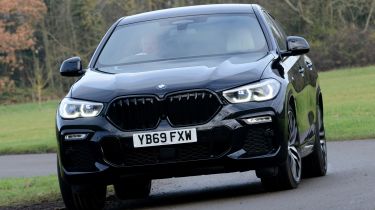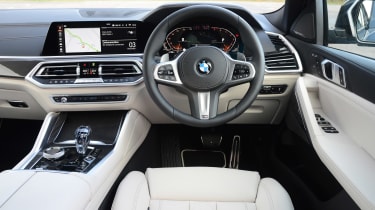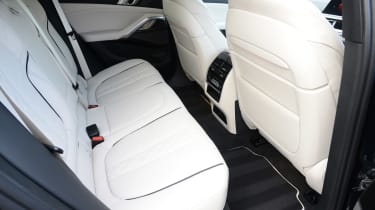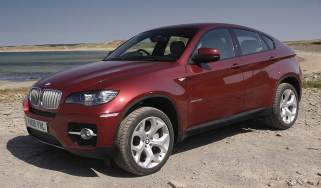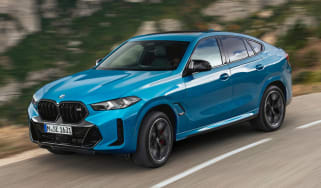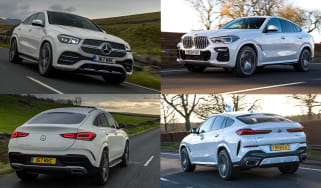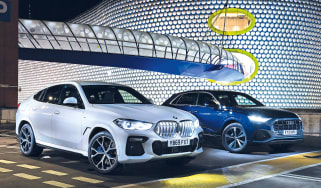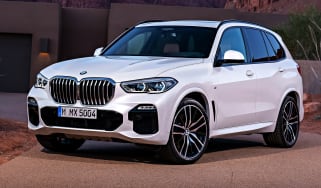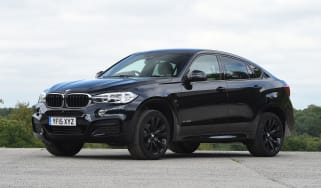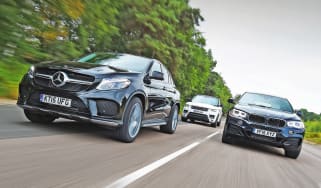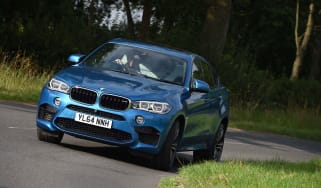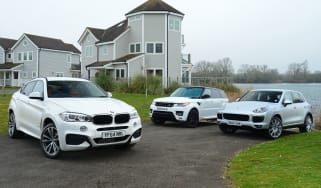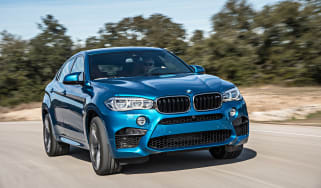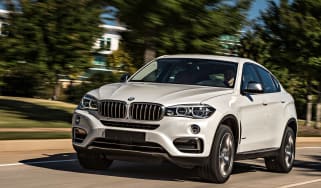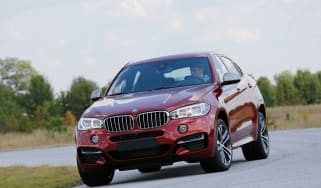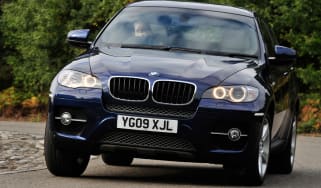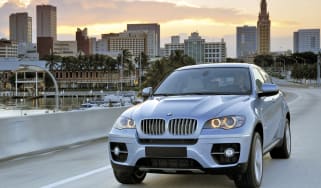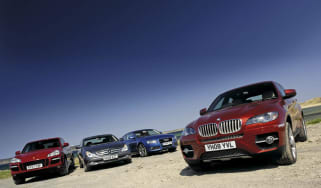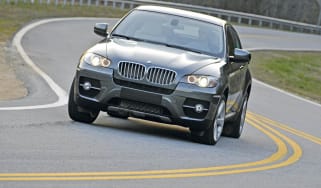BMW X6 review
BMW’s latest X6 is its best take on the format yet, and as good to drive as ever

Whatever you think of the styling, BMW’s latest X6 is a competitive SUV coupe. Its driving characteristics and equipment are towards the top of the class and it performs well too, with the X6M being an absolute rocketship. Diesel versions still make the most sense in terms of running costs and drive well, while thanks to a larger cabin than before, interior practicality is good too. It’s a competitive class though, and rivals such as the Mercedes GLE are still compelling alternatives, so the new X6 isn’t quite the outright class leader.
About the BMW X6
The BMW X6 is a car that divides opinion, either the perfect interpretation of the sports SUV format with all BMW’s usual qualities, or a needlessly large, heavy and aggressive vehicle representative of the profligacy with which we consume resources. Whichever camp you fall into though, the X6 is clearly successful for BMW, and the latest model is also the best yet - less cumbersome than before, not as thirsty, better to drive and more generously equipped.
Nor is the more coupe-like styling quite the hindrance to practicality it might once have been. BMW has enlarged the X6 for the latest generation, finding extra space between the wheels and expanding cabin and boot as a result. While you don’t get a seven-seat option like you do in the X5 with which the X6 shares virtually everything, there’s still a large boot, a rear cabin that accommodates even taller frames, and an interior that’s generally spacious, comfortable and well-built.
Used - available now
There’s a usefully wide range of engines too, covering everything from the sensible inline-six diesel models with economy that gets close to the 40mpg mark, to the barmy X6 M Competition which is one of few SUVs you might consider taking anywhere near a circuit, and not just because it’s towing a single-seater race car. All X6s drive well too, with a fine balance of ride and handling and good long-distance comfort - though the X6 removes that ride quality factor from its own equation, being rather rough on typical UK roads.
Equipment levels offer no surprises with the usual Sport and M Sport trims offered in combination with the 40i petrol and 30d/40d diesel models. Standard kit includes 19-inch alloys, adaptive LED headlights, heated front sports seats finished in Vernasca leather upholstery, an automatic tailgate and BMW’s Live Cockpit Professional infotainment set-up.
It’s a good example of its type then, lining up against rivals such as the Mercedes-Benz GLE Coupe, Porsche Cayenne Coupe and Range Rover Velar, while the Audi Q8 Sportback e-tron offers an all-electric alternative. All of these models require buyers to dig deep into their pockets, however. The X6 starts from more than £67,000, with the X6 M Competition around £124,000.
Engines, performance and drive
It’s been a long time since SUVs as large and heavy as the X6 have been sluggards. BMW was among the first to give an SUV a true performance bent with the original X5 in the 1990s and today’s X6 is both quick and a surprisingly adept handler even in its humblest 3.0-litre diesel form. Inline six and V8 engines are the order of the day, as are eight-speed gearboxes and standard xDrive all-wheel drive. Whichever power unit you go for, there’s both performance and refinement in spades, along with smooth shifts from the auto ‘box.
It’s capable in the corners too. You’ll not notice a whole lot of difference between the X6 and its more practical X5 equivalent, despite the sportier styling - perhaps only a touch more precision to the steering of the X6 and marginally less roll, perhaps on account of there being less metal above your head. But in class terms the X6 drives well, and the ride is very good too. Well, with the exception of the X6M Competition - it might have mighty performance and physics-defying levels of grip and control, but the trade-off is a ride that crashes and thumps on British roads.
0-62mph acceleration and top speed
A pair of petrol and a pair of diesels power the mainstream X6 range. The xDrive40i, 30d and 40d models are all based around 3-litre inline six-cylinder units while the M50i uses a 4.4-litre V8. All move the car along with quite some conviction, with even the 282bhp 30d enough to motivate the X6 to 62mph in 6.1 seconds. The 40i petrol is a mite quicker, its 328bhp turbocharged six good for the same sprint in 5.7 seconds, while the 40d is even more potent on paper and on the road, with a 335bhp output and the ability to reach 62mph two tenths quicker than its petrol equivalent.
The X6 M50i sits top of the tree though (with one qualification, which we’ll come to in a second). Its 4.4-litre turbocharged V8 makes 523bhp, making it capable of 0-62mph in 4.3 seconds. All bar the 30d, meanwhile, will run up to a 155mph limiter given a long and legal enough stretch, while that entry-level diesel will still manage 143mph.
And that exception for the M50i being top of the pile? That’s the X6M Competition of course, whose own iteration of the 4.4-litre turbo V8 makes 616bhp, 750Nm of torque and will dispatch the 0-62mph measure in 3.8 seconds. Top speed is the same 155mph, but as ever with M Competition vehicles you can ask BMW nicely to raise that limit, which brings top speed up to 180mph.
MPG, CO2 and running costs
Diesel still rules in this class for fuel economy and CO2, particularly when there’s no plug-in hybrid available. That leaves the xDrive 30d as the most frugal of the X6 range, capable of up to 42.8mpg, depending on specification, with corresponding CO2 figures of between 172 and 188g/km. Next up is the 40d, whose 38.7-41.5mpg numbers are surprisingly not too far behind despite the extra output - it’s still using essentially the same 3.0-litre inline six diesel engine, just in a different state of tune. CO2 here is quoted as 179-193g/km, again depending on factors like wheel and tyre size.
The petrols will guzzle slightly more than their diesel counterparts both in the lab and on the road. For the 40i that means around 30mpg and CO2 of more than 200g/km, while the M50i registers 24.4-25.0mpg and up to 265g/km of CO2.
If the X6 M Competition topped the tree for performance then it’s somewhere underground in terms of economy, with slightly terrifying WLTP combined economy figures of 21mpg and entire clouds of CO2 exiting the tailpipes every kilometre. If you choose to exploit the X6 M's full performance then be prepared for the fuel gauge to drop rapidly.
Insurance groups
Insurance premiums will be high whichever X6 model you opt for. In fact, the 30d version in Sport trim is the only X6 not to be in the highest group 50, although you probably won't save too much as it sits in group 49.
Depreciation
Customers should see pretty decent residual values for the the X6 over three years and 36,000 miles of ownership. Our expert data suggests that, on average, the coupe-SUV should retain between 52 and 54 per cent over this period, with the 30d models performing the best.
To get an accurate valuation on a specific model check out our free car valuation tool...
Interior, design and technology
The X6's cabin is similar to its X5 sibling, and that’s no bad thing. The dashboard design is typical modern BMW and with a few old-school BMW touches, such as a centre console subtly angled towards the driver. In brighter trim shades in particular it’s a pleasant place to sit, with well-judged use of high-quality materials pretty much everywhere you choose to look and touch.
There’s leather covering many of the surfaces, some aluminium trim to brighten things up, and logically-arranged controls, with the sensible use of buttons and knobs rather than widespread touchscreens. BMW has included some neat details too, such as the crystal-effect gear selector. We’re less sure about the fat-rimmed steering wheel (though it looks good, admittedly) and also the instrument display ahead of the driver.
The display is certainly fancy with its counter-rotating speedometer and rev counter gauges, but their geometric shapes aren’t anything like as easy to read as BMW’s traditional analogue gauges of yore - you’ll spend more time looking at the digital numerals in their centres, or BMW’s excellent head-up display, where fitted. Seat comfort is very good, though.
Sat-nav, stereo and infotainment
Once upon a time BMW’s iDrive infotainment system was a nightmare to navigate, but with a few decades to figure things out it’s now among the better systems on the market. The X6 is now on version 7.0 would you believe, comprising a large touchscreen system in the centre of the dash, angled towards the driver as it should be, which can be operated either by prodding it, or with the usual clickety wheel on the transmission tunnel or voice activation.
The system includes smartphone connectivity with Apple CarPlay but BMW’s built-in software, navigation and audio options are pretty good in their own right and invariably the physical iDrive wheel is the safest and most intuitive way to navigate the menus on the move.
Practicality, comfort and boot space
BMW’s X6 has grown this time around, though you’d not know it as the latest styling isn’t quite as imposing as before - or maybe that ever-increasing kidney grille just makes the rest of the car look smaller. The most important measure is that the X6 gets a larger wheelbase than its predecessor, in line with the X5, bringing a usable increase in passenger space.
Storage within the cabin is pretty good too, with a large compartment between the front seats, good door bins and a large glovebox, while all passengers enjoy comfortable seats - though unlike the seven-seat option in the X5, there are only five seats here thanks to that lower roofline. The view out of the front is fairly commanding too but rearward visibility does suffer a touch, so when parking in particular you’ll be thankful for the parking sensors and rear-view camera.
Dimensions and size
Personal taste for the styling aside, BMW’s done a good job of hiding an increase in size between the last X6 and the latest model - you’d swear it looks smaller, but it’s larger in every dimension than its predecessor. It’s 26mm longer (4,935mm total), 15mm wider (2,004mm), and comes in at 1,696mm tall, and its wheelbase (2,975mm) is 42mm larger than before, to the benefit of interior volume. For the record, the X5 on which the X6 is based is actually a touch shorter at 4922mm, the same width, and taller at 1745mm, though naturally they share an identical wheelbase. The X6 weighs between 2,055kg and 2,260kg.
Leg room, head room & passenger space
With a more sloping roofline than a typical SUV there’s a risk that the X6 might compromise space for rear passengers, particularly in terms of headroom, but thankfully that isn’t the case. BMW’s efforts to find more interior room mean the X6 feels spacious whichever end of the cabin you’re sitting in, but there’s no real penalty for those in the rear in particular, with good legroom and headroom - though with that lower roof, taller folks may need to pay attention to avoid headbutting the slightly smaller door aperture.
The front cabin is little different from the X5, so it looks and feels spacious and the seats should amply accommodate most body types. There’s a large range of adjustment in the seats and the wheel which makes finding the right driving position a doddle.
Boot space
The rakish X6 shape packs a 580-litre boot with the rear seats up, expanding to 1530 litres with the seats folded forwards, something they do in a 40/20/40 format for good adaptability depending on the load you’re intending to carry. These numbers compare well with the more practically shaped X5, though naturally you’ll still get more in that car, with a 650-litre boot and up to 1870 litres if you drop the rear seats.
Reliability and safety
Precise safety ratings for the latest X6 are not yet known, as EuroNCAP has not yet put the car through its crash test regime. It has tested the very similar X5 though, so you can infer from those tests that the X6 should be similarly safe.
Tested in 2018, the X5 received a full five-star rating, scoring 89 per cent for adult occupant safety, a strong 86 per cent for child occupant safety, 75 per cent for vulnerable road users (often referred to as pedestrian safety) and 75 per cent for its safety assistance systems.
There’s a healthy suite of technology aimed at reducing the chances of an accident, including active emergency braking capable of detecting pedestrians, cyclists, other vehicles and static objects, plus speed and lane assistance functions and for pedestrian safety, an active bonnet. X6s feature the same level of technology as the X5.
The X6 didn't appear in the most recent 2022 Driver Power Survey. The 3 Series was the highest-ranked BMW model in 32nd position out of 75 cars, while BMW itself finished in 16th place out of 29 brands - a solid improvement on the 21st spot achieved in the previous year's poll.
Warranty
BMW offers a three-year unlimited mileage warranty on all its new vehicles, including BMW Emergency Service for what it calls “unforeseen events”. There’s also a two-year warranty on all genuine parts. This level of warranty cover is pretty standard among BMW’s rivals - Mercedes-Benz also offers three years, while Audi’s standard UK warranty is two years with unlimited mileage and a third year with a 60,000-mile cap.
Servicing
BMW offers monthly payment-based service plans for all its vehicles, fixed for the duration of your ownership, with X6s costing around £30 per month over 36 months. The car will alert you to variable mileage intervals or typically every twelve months.

